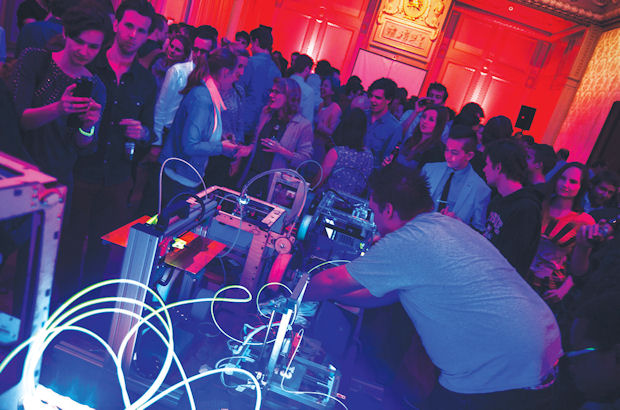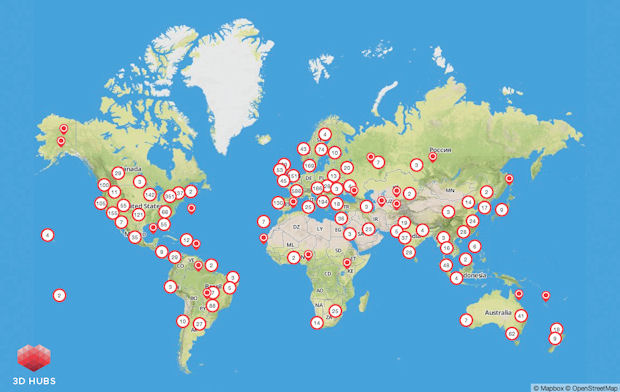
Members of regional communities can plan events to discuss ideas, show projects and help promote 3D printing technology. Images courtesy of 3D Hubs.
December 1, 2014
 Members of regional communities can plan events to discuss ideas, show projects and help promote 3D printing technology. Images courtesy of 3D Hubs.
Members of regional communities can plan events to discuss ideas, show projects and help promote 3D printing technology. Images courtesy of 3D Hubs.The 3D printing market raked in $3.07 billion in 2013, achieving its highest compound annual growth rate (34.9%) in 17 years, according to industry research and consulting firm Wohlers Associates. While there is still plenty of room for growth, there are a number of 3D printers out there not living up to their full use potential.
Enter 3D Hubs, a company based in Amsterdam that looks to bring people in need of 3D printing together with 3D printer owners via decentralized, local manufacturing. Founded in 2013 by two former 3D Systems employees, the company now has Hubs all across the globe—from New York to Tehran. In fact, the company recently opened a second office in its New York community, which has 636 end users who can access 140 local 3D printers.
“We have now built the biggest decentralized production there is,” says Filemon Schoffer, head of community at 3D Hubs. The network boasts over 8,000 Hubs, with new printers being added daily, according to Schoffer.
How Does 3D Hubs Work?
To create a print, 3D Hubs users can upload their files to a service such as Thingiverse or Cubify and select a local printer in the area. The Hub will then receive notification of the job and can decide to accept or decline the offer within 24 hours.
If a print job is accepted, the file is then sent to the team at 3D Hubs. The team checks the watertightness of the model and makes any needed repairs with automated software. Once the model has been prepared and is ready to go, the object is printed. The designer can then arrange to meet with the printer or simply have the prototype shipped. The company has also added 3D modeling, finishing, shipping and support material for Hubs that may need outside services.
Once an order is completed, customers have the opportunity to review it with a 5-star rating system. A Hub can be rated on the four following areas: print quality, service, speed and communication. This is also a chance for customers to provide feedback to the Hub and 3D Hubs.
If a service is unsatisfactory, or a dispute arises, Schoffer says the company will reach out to the respective parties and act as a moderator to figure out a solution for both. Because it’s a young market, he says the company is proactive about fixing issues, but that disputes are rare within communities.
Pricing and Materials
The Hub owners themselves decide how much they decide to charge per print. When setting prices, 3D Hubs suggests owners price similarly to other community members. According to the company, average earnings per print are $38 (€30), but some jobs have earned more than $300 (€250).
Hub owners can list a printer for use at no cost. Once the Hub becomes operational, 3D Hubs takes 15% of each order for start-up costs, and the owner pays for materials. While any type of system can be used, Schoffer says 3D Hub’s pricing system is optimized for Fused Deposition Modeling (FDM) printing.
Available materials vary depending on a specific Hub. With over 8,000 printers worldwide, Hubs can offer materials such as PLA (polylactic acid), ABS (acrylonitrile butadiene styrene), FlexPLA, Wood, T-Glass and more.
Opportunities & Challenges
While targeted primarily to makers, engineering teams could make use of 3D Hubs. One option is to establish a Hub and start printing. This is an outlet for engineers to use their printing resources regularly and have the chance to earn money as well as collaborate with other designers in the area.
Additionally, engineers could use the service for their own 3D prints, possibly benefitting from faster delivery times and lower production prices if printers are found within their city or even neighborhood. In the ideal scenario, shipping is not needed, and the printer and end user can meet as soon as the project is completed, Schoffer says.
Some professional engineers are already using the service. For example, smartphone manufacturer Fairphone aims to make its products with transparent practices and conflict-free materials. It recently decided to manufacture all of its smartphone accessories through 3D Hubs’ printers.
“We’re disrupting now how the way things are being made by companies, so it’s a lot more than just connecting people with 3D printers to people who want to 3D print,” Schoffer says.
Though 3D Hubs does offer opportunities for both professional engineers and makers, there are also some challenges to the program when compared to a more traditional 3D printing or rapid prototyping service bureau. First is availability of materials and equipment. Because each Hub is run by an individual, specific materials and colors may not be offered. The manufacturing is often done with a single printer, so local Hubs are often not equipped for large-scale jobs.
Another potential hurdle to using 3D Hubs is location. The network is expanding and adding new hubs regularly, but there still is no guarantee of finding a printer nearby.
The third challenge to overcome is expertise. Most traditional 3D printing service bureaus will guide customers through their project and suggest the best 3D printing technologies for their needs, but 3D Hubs relies on its community for that.
More Than A Printing Service
3D Hubs’ communities are a way for makers and printers to connect outside of the traditional business transaction. One popular way for community members to connect is through hosted events, which can range from 3D printing roundtables to meetups, store openings and more.
“The maker movement became very strong on our platform, so we definitely brought them in touch [with one another] to share, tell them how to be a successful Hub and basically leverage from the community as a whole,” says Schoffer. “I believe [it’s beneficial] to get people together and talk. Online is good for business and can do a lot, but it’s missing that community aspect.”
To monitor every community, 3D Hubs has established the role of mayor. Responsibilities for this role include event organization, community support and community growth. It is also a way for 3D Hubs to promote its business offline. Mayors are available to Hub owners as support staff to help them grow their own businesses and bring 3D printing to the community at large. With mayors, the company is able to host more events worldwide, and recently held 13 events in one week. “It’s a social effect, it’s also a bit of belief,” Schoffer says. “We believe it’s the way to go, the way to approach the maker movement.”
Also available is Talk, an online community for users to ask questions, share projects and print as well as announce events. This offers Hubs that may be in remote locations—such as Tahiti or Central Russia—a chance to be a part of 3D Hubs’ communities, even without needing to be physically near other Hubs. This online community is still in beta, Schoffer says, and is something the company is hoping to expand and eventually offer as specialized communities for different interest areas of 3D printing.
“Aside from connecting individuals to individuals, the whole company aspect will be very important … We really want to see the impact of bringing manufacturing into the hands of the people on a professional level,” he says.
More Info
Subscribe to our FREE magazine, FREE email newsletters or both!
About the Author
Jess Lulka is a former associate editor for Digital Engineering. Contact her via [email protected].
Follow DE






